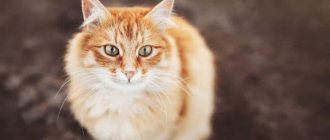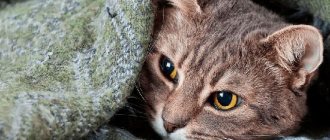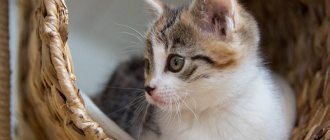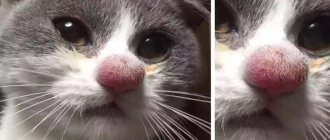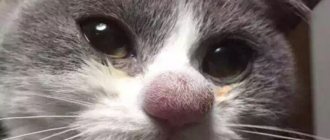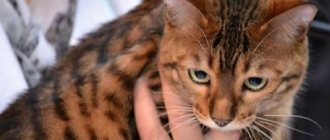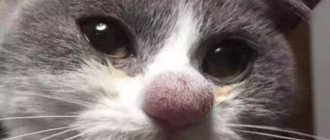Normal condition of a cat's nose
If the animal is in good health, its nose will be wet and slightly slippery. This physiological state is explained by the fact that cats regularly lick their tongues, releasing a specific secretion that plays the role of protection.
- A cat’s nose is not only an organ for smell perception, but also an “indicator”. With the help of this important organ for detecting scents or “hide” from the victim, he can easily scout the temperature of nearby objects and the direction of the air mass.
- Don't panic if your little animal sometimes has a warm, dry nose. This is a normal phenomenon and is explained by the fact that kittens have not yet learned to maintain hygiene, and the cells of the mucous membrane do not produce enough secretions.
In this case, the little “whiskers” hope for the help of their mother cat. If they are separated from their mother too early, then all responsibility in this regard falls on the shoulders of the owner.
What kind of nose should a healthy pet have?
Many owners are concerned with the question of what a healthy kitten’s nose should be like. First of all, a healthy nose is a moist and cool nose that glides a little. This is due to the nature of the animal. In fact, cats are predators for whom the nose is the main assistant in the hunt. The wet organ helps determine where the wind is blowing - this is necessary so that the victim does not smell the cat's scent. This is why having a wet nose is important.
When determining the health of a pet, it is necessary to take into account the type of activity of the kitten. If he has just woken up or was engaged in active play, then he may experience a dry nose. This is due to the fact that pets have a higher body temperature than their owners, and therefore moisture evaporation occurs more intensely. Physiological causes of dryness are:
- dream; awakening; active games; hot room; sharp fear; prolonged exposure to the sun; sedentary lifestyle.
When is dry nose normal?
Under normal conditions, the causes of a dry nose in a cat can be completely different:
- If your pet is having sweet dreams or just woke up;
- If you have been in the sun or near a radiator for a long time;
- If he is worried about something;
- If he actively frolics;
- In dry and high room temperatures;
- If your cat is in heat.
If your ward is a little overheated in the sun or rushed around the room for a long time, the body temperature will gradually return to normal. Also, pets clearly do not practice hygiene during sleep, which is why most often their nose becomes dry when they wake up.
Also, the nose stops being wet if it is clogged with dirt and dust. In this case, you need to try to pay attention to the nasal passages. But the nose of the nose does not always accurately determine the health status of your pet.
To be more convincing, you need to check the temperature of the ears - this is an indicator of body temperature. A jump in temperature is normal for kittens and for a cat who has recently given birth.
Gradually, everything will return to normal, and your pet’s health will not differ from other healthy cats. In this case, the services of a veterinarian will not be needed. What to do if your cat has a dry nose and his health does not improve? Take your temperature rectally.
Reasons and what to do
Pathologies are caused by various factors - hypothermia, heat stroke, stress. In some animals, dry nose occurs due to overeating. Then it is enough to reduce the number of servings. It is important that a bowl of clean water is available.
Often, when playing, pets swallow small objects. Then it is necessary to urgently show the cat to the veterinarian; emergency surgery may be required. If the cause is active games or prolonged exposure to the sun, you need to provide your pet with peace, a cool place, and access to water. Then the temperature will return to normal on its own, and the nose will become moist again.
Pets often eat the powder that is poured in to kill cockroaches (if the poison is placed in an accessible place). If you have the skills, you can do a gastric lavage and take the cat to the clinic. In case of poisoning, probiotics, solutions for dehydration (drips are placed), medications for nausea, vomiting, and diarrhea are prescribed. Painkillers and antibiotics can be used.
If the cause of a dry nose is an allergy, give antihistamines, remove the provoking factor, do wet cleaning, and ventilate the room. To increase humidity, you can spray the rooms with a spray bottle.
As first aid, the cat is given antipyretics or painkillers, but the temperature is reduced only if it is above 40 °C. If the animal has a cold and the nose is dry due to the sinuses being clogged with exudate, you need to carefully clean the canals.
However, self-medication is not recommended. Some even simple manipulations (for example, cleaning the sinuses) without experience lead to mechanical damage, which will aggravate the animal’s condition. Also, before treatment, a diagnosis is made, which only a veterinarian can do.
To determine the disease, laboratory tests, x-rays, and ultrasound are required. When prescribing medications, it is important to choose them correctly and calculate the dosage, otherwise you can only harm your pet. Therefore, it is important to take the animal to the clinic immediately.
If the veterinarian is called home, before the doctor arrives, you can wet the pet’s nose with cool water, spray long-haired animals with a spray bottle, wipe them without fur with wet wipes, and give them water. If the cat does not drink on its own, inject it with a syringe (without a needle).
Antipyretics (for example, Aspirin, Paracetamol) are not recommended to be given before the doctor arrives. Drugs intended for humans can be dangerous for animals; strict dosage is required. Instead of taking medications, you can reduce the fever by applying ice packs to the groin, head, armpits, or wrapping them in a cold, wet cloth. But you can’t keep the cold for long; you need to constantly change the location.
Respiratory viral disease
In this case, the temperature rises by 1-1.5 degrees. The exudate comes out in the form of mucus, often watery and light. The pet's condition is satisfactory, the cat does not refuse food, but its activity is slightly reduced.
For treatment, broad-spectrum antivirals are prescribed. Antipyretic medications are not required. Additionally, immunomodulatory drugs and vitamin complexes are prescribed.
Bacterial respiratory disease
At the same time, the temperature is 1.5-2 degrees above normal, which is already considered high for a cat. Exudate is thick, with an unpleasant odor. Discharge – green, yellow, white. Additionally, shortness of breath and cough appear. The cat loses her appetite, there is no activity, she only gets up to drink and go to the litter box.
At the initial stage of the disease, the pet is given antitussives. If phlegm is not produced, it can damage the bronchi. As soon as exudate appears, the cat is prescribed expectorants to quickly remove mucus. Additionally, antipyretic medications and antibiotics are given.
Sepsis
With sepsis, there is a strong increase in temperature - by 2-3 degrees. The mucous membranes turn red, and pinpoint hemorrhages are often visible inside the membranes. The cat does not respond to external stimuli, the condition is serious, cannot reach a bowl of water or go to the litter box, relieves itself on the bedding, lying down.
Strong systemic antibiotics are prescribed. Additionally – antipyretic and anti-inflammatory drugs. The cat must be hospitalized so that it is under constant monitoring - urgent resuscitation may be required. In the hospital, the animal is given IV drips, intravenously administering maintenance medications with nutrients, glucose, and vitamins.
Helminthiasis
In the presence of worms, the temperature rarely rises, and severe diarrhea often occurs. If the intestinal mucosa is damaged, blood clots are visible in the stool, and a strong putrid odor emanates from it. When diarrhea occurs, dehydration occurs. The mucous membranes and nose become dry.
To destroy worms and their larvae, deworming is carried out. But first, the type of parasite is identified. Depending on this, medications are selected or complex agents are prescribed that act against most types of helminths. Usually one treatment of the cat is enough, a second treatment is carried out as a preventive treatment - after two weeks, but with a different drug.
Cardiovascular failure
The cat walks hunched over, curls up, and often presses its front paws to its sternum. Lies in one position for a long time, does not respond to calls, commands, or external stimuli. Often additional shortness of breath and pale mucous membranes appear (due to a drop in blood pressure). The cat is given an ECG and diagnosed with heart failure.
It is strictly prohibited to treat your pet on your own. The cat needs to be taken to the vet immediately. The doctor conducts a full examination, determines the cause, and prescribes treatment depending on it. It includes sedatives, anti-inflammatory, cardiac glycosides.
Pulmonary failure
The main symptoms of pulmonary failure are blue discoloration of the mucous membranes due to a lack of oxygen in the blood, shortness of breath. Other signs include cough, mucus from the nose (can be of different colors, thicknesses) with an unpleasant odor, high fever, dry, hot nose. A severe form of the disease is manifested by sputum with blood, tachycardia, short-term fainting, and loss of consciousness.
Treatment with home remedies is strictly prohibited. The cat needs urgent examination. The cause of the disease can only be determined in a veterinary clinic. The therapeutic regimen includes antispasmodics, antipyretics, expectorants, and anti-inflammatory drugs.
A dry nose in a cat is normal if this condition lasts for a short time. For example, when an animal is sleeping, it lies near the battery for a long time. After waking up, your pet's nose remains dry for another half hour. Then it becomes wet again. If dryness lasts more than two hours and other negative symptoms appear, the cat should be taken to the vet immediately. This may indicate serious illness.
Dry nose in a cat is a sign of pathology
If none of the natural causes are suitable, and you could not understand why the cat has a dry nose, and the outer part of the sense of smell remains warm and dry, then this may indicate the presence of a disease.
If the cat does not eat anything and has a dry nose, lethargy, drowsiness, diarrhea, an abnormal heart rhythm, he is always worried about something and drinks a lot of water, he feels sick, vomits, shortness of breath and discharge from the nasal passages and eyes appears, - all these indicators are signs of the development of pathology.
- It is necessary to pay attention to the health of the animal even if the cat is sneezing and has a dry nose.
- This can be a signal of any respiratory disease, fungus and viral infections.
- Sneezing is often accompanied by vomiting, lacrimation, fever, and difficulty breathing.
- In such cases, you need to take a closer look at the change in the color of the cat’s nose.
If it begins to acquire a yellowish tint, then this is a signal of kidney failure; cyanosis is a sign of problems with the respiratory system. The nose turned significantly red - evidence of a burn.
Pale indicates heart pathologies, and an unnaturally pink nose indicates some kind of infection. But only a veterinarian can make an accurate diagnosis. To determine the exact cause of the violations, he will examine the pet and conduct several studies.
Why does my nose feel dry and hot?
If the physiological causes of drying and warming of the nose are discarded and the time period during which this fact is observed begins to be alarming, then the cat is definitely sick. The exact cause and diagnosis can only be made by a veterinary specialist after an in-person examination and passing the necessary tests on the animal (if necessary).
Possible causes of a dry and hot nose:
- internal infections (viral or bacterial);
- inflammatory process of any localization;
- fur in the stomach or intestines;
- dehydration due to diseases or unfavorable conditions in which the cat is kept;
- urolithiasis and any kidney pathologies;
- cat colds;
- nasal injuries;
- poisoning or digestive disorders.
First aid if your cat has a dry nose
There is no need to panic if a dry nose is caused by a number of natural causes. But if this continues after several hours, and your pet’s health is clearly deteriorating, it is recommended to seek help from a veterinarian.
Treatment at home can only do harm, because it is almost impossible to determine the reasons for the deterioration of the condition. Self-administration of aspirin or paracetamol can lead to dangerous complications in the animal's body.
Of course, if you can’t immediately seek help from a clinic, you can try to provide first aid to your pet at home. Dehydration is the main enemy when the animal’s temperature rises. Therefore, you need to give your cat a lot of cool water.
- If he refuses to drink, you need to give him water from a syringe or pipette.
- If the animal has little fur, it can be rubbed with a cool towel or napkin; cats rich in fur can be sprayed with a spray bottle.
- If the temperature is higher, you should try to bring it down by applying cold compresses.
You can also wrap a small bag of ice in a cloth and apply it to your groin and head. But do not overdo it - such procedures cannot be carried out for a long time.
Examination of the mucous membrane
The mucous membrane is inflamed, there are wounds, ulcers, this is definitely stomatitis . The presence of a problem can be determined by feeling the animal's abdomen. If your pet looks sick, this is one of the signs that the disease is really present. You should watch him and take action if he is sick. If necessary, show a doctor. Treatment should only begin if there is a correct diagnosis.
An increase in the animal's body temperature is the most common cause of the disease. If your pet has stomatitis, treatment should be started immediately. It is recommended to treat the animal's oral cavity with disinfectants . You can use a solution of baking soda, hydrogen peroxide, and a weak solution of furatsilin.
I lubricate the wounds with Lugol's solution along with glycerin; this solution can also be used to lubricate ulcers. For rapid healing of wounds and ulcers, regular vitamins are recommended.
Actions of the veterinary clinic
When contacting a veterinary clinic, the doctor first acts as follows:
- Conducts a general clinical examination;
- Measures body temperature;
- Collects information about the history of the disease;
- Takes urine and blood tests.
The main causes of dry nose in a cat are benign and malignant formations in the nasal sinuses, mechanical injuries (for example, a foreign body), chronic runny nose or viral infections. Depending on what pathology the doctor identifies, a course of treatment, and possibly a whole range of treatment procedures, is prescribed.
What does the color of a cat's nose mean?
Initially, the pigmentation of a cat's nose depends on the color of the animal.
In most cases, it is colored the same color as the fur on the animal’s face, but several shades darker. Some representatives of the cat family have so-called “moles” on the nose - pigment spots that can be more or less noticeable. With age, the skin on your pet's nose and paw pads may become darker - this is normal. Of course, if your pet’s nose is dark gray or black, then you can hardly judge the state of the animal’s body by the change in its color. However, in cats with light pink noses, changes in the pigmentation of this part of the face make it possible to timely diagnose one or another deviation from the norm. For example, a bluish tint to the skin on an animal’s nose may indicate a lack of oxygen or a pathology of the cardiovascular system. Redness of the nose should make the attentive owner suspect mechanical injury to its surface, and may also be a consequence of too much exposure to the sun or a symptom of an allergy. Finally, a yellowish tint to the nose is a sign of pathology in the cat’s liver or kidneys.
One of the most common veterinary myths: if a cat has a hot nose, this clearly indicates illness. Indeed, many diseases provoke drying of the surface of the lobe (this is what the tissue around the nostrils is called), but in most cases this symptom is a variant of the norm. A responsible owner should be able to figure out in what cases it is necessary to contact a veterinarian, and when there is no need to worry.
The temperature of a healthy cat's nose changes several times during the day. The structure of the fabric may also change slightly. Therefore, if you want to regularly feel the muzzle for diagnostic purposes, then it is better to do this 2 times a day (immediately after the animal wakes up and during the period of maximum activity).
In professional veterinary medicine, the results of palpation alone are not strong enough to make a definitive diagnosis.
There are several physiological reasons why a cat’s nose becomes hot:
- The animal recently woke up. The wetness of the lobe largely depends on how often the cat licks his lips. During sleep (and this is absolutely natural), he cannot wet the dry tissues with saliva. Eventually, local temperatures may rise slightly.
- Exposure to sunlight. Even a short walk outside in the open sun will dry out your nose and temporarily increase the temperature of your nose.
- Exposure to too dry and hot air. During the winter months, your pet will usually huddle close to the radiators to keep warm. If there is no humidifier in the apartment, then it is likely that the cat’s nose will become dry and hot.
You should not worry or try to provide any help to your pet if its behavior and general condition have not changed in any way. The temperature and humidity of the nose will recover on its own.
What can a cat do to prevent dry nose?
To prevent pathologies accompanied by dry nose, there are several rules:
- Creating a cozy atmosphere in the apartment. To do this, it is necessary to regularly carry out wet cleaning of the premises, ensure that there is free access to water, and maintain optimal humidity in the apartment using special devices;
- Constantly monitor the animal’s well-being, pay attention to changes in condition;
- To identify the early stages of pathologies, be observed by a veterinarian at least once a year for the purpose of prevention;
- Get vaccinated and antiparasitic treatment.
If you notice the first signs of a deterioration in your animal’s health, don’t delay! Seek help from a doctor and under no circumstances self-medicate!
